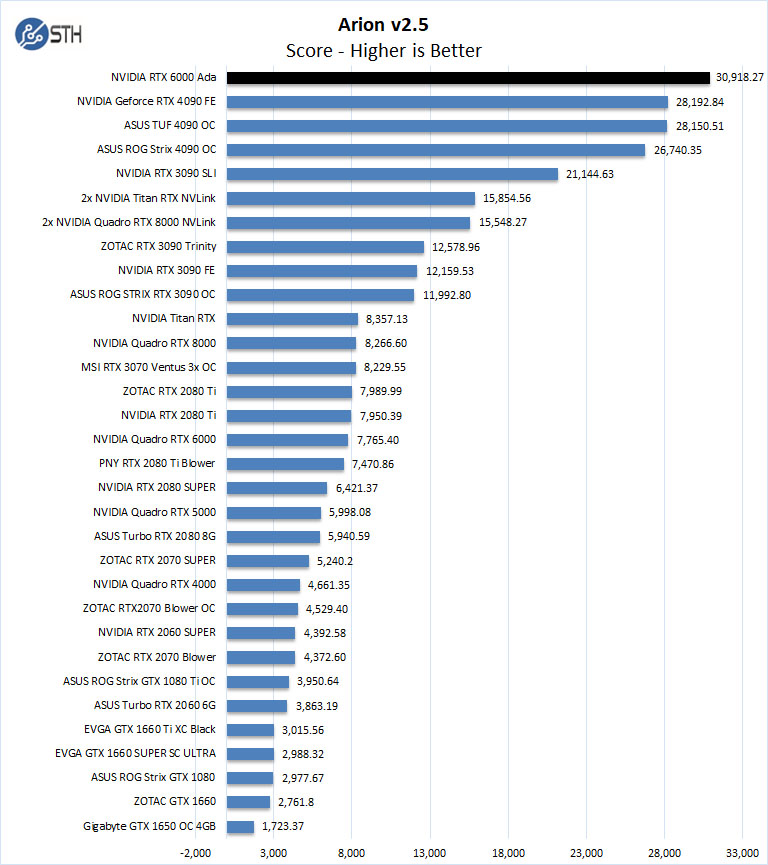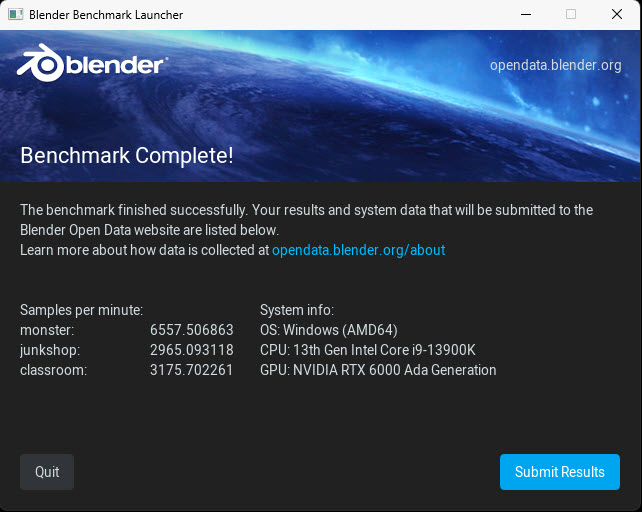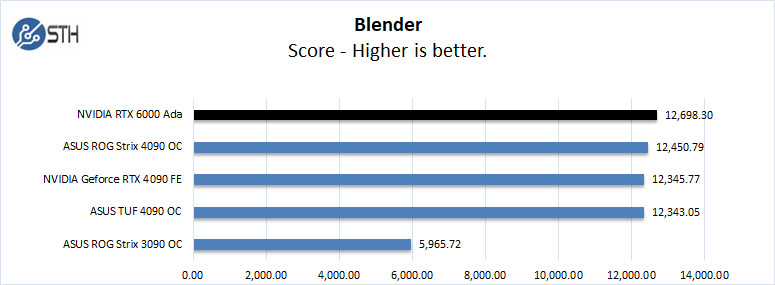Rendering Related Benchmarks
Next, we wanted to test the rendering performance of the card.
Arion v2.5
Arion Benchmark is a standalone render benchmark based on the commercially available Arion render software from RandomControl. The Benchmark is GPU-accelerated using NVIDIA CUDA. However, it is unique in that it can run on both NVIDIA GPUs and CPUs.


The RTX 6000 Ada gets a big boost in results using Arion. Again, we are seeing at least 50% gen/gen performance boosts with more than 3x the performance of the RTX 6000 and RTX 8000 comparing a two-generation upgrade cycle.
KeyShot
The KeyShot Benchmark is a simple yet powerful tool to test your CPU and/or GPU and evaluate their performance. KeyShot Viewer is a free standalone application for sharing KeyShot scenes for others to view and interact with your visuals.

The results are multiples based on render time. Higher scores than 1.0 are better than the reference system. The reference system is a relatively ancient Intel Core i7-6900K CPU @3.20GHz, 2601 Mhz, 8 Core(s). A score of 1.0 matches the speed of the reference system. A score of 2.0 would be double the speed of the reference system.
As we can see, a score of 186.53 is almost double the speed of the reference system. Our Intel Core i9-12900K (8x Performance Cores / 8x Efficient Cores – 16x Threads) generated a score of 2.46. For a total score of 190.62.
OctaneBench
This Benchmark has a new version. This will be one that we update with future GPUs as we add them to the data set.


In this Benchmark, the NVIDIA RTX 6000 Ada generated a score of 1,160.02 as it tries to keep up with the GeForce RTX 4090 GPUs.
Blender Benchmark
You can download the Open Data Benchmark from the opendata.blender.org homepage with Windows, Linux, and macOS versions. You can then select any 7 benchmarks (details listed below) to run on your Blender version and render device (CPU / GPU). The Benchmark will also gather non-identifiable data on your system setup, details of which can be found below. Once the Benchmark is complete, you can publicly share your results on Blender Open Data.



The NVIDIA RTX 6000 Ada showed excellent results and topped the chart with its 12,698.30 point score vs. the highest recorded at Blender – Open Data at 12,167.93. This is also more than 2x the Ampere generation.
V-Ray
V-Ray does Photorealistic rendering and real-time visualization using CUDA and RTX benchmarks.
V-Ray GPU CUDA

V-Ray GPU RTX

In these two benchmarks, the RTX 6000 Ada comes close but is slightly behind the GeForce 4090 results. It is also in another league versus the Ampere generation.
UL Procyon
UL Procyon—benchmarks for professional users. Procyon is a new benchmark suite from UL that we’re creating specifically for professional users in industry, enterprise, government, and retail.
UL Procyon Video Editing
This Benchmark compares the video-editing performance of Windows PCs aimed at creators, enthusiasts, and creative professionals. This test is based on the typical workflow when creating content for online video-sharing platforms.
The Benchmark uses Adobe Premiere Pro to export video project files to common formats. Each video project includes various edits, adjustments, and effects. The benchmark score is based on the time taken to export the videos.


The RTX 6000 Ada took hit in performance in the Video Editing benchmark but pulls ahead in Photo Editing by a large amount.
Next, we will have Uniqine and 3Dmark-related Benchmarks before moving on to power consumption, thermals, and our final thoughts.




nice review, was wondering why the RTX A6000 wasn’t taken into the comparisons, the “original” RTX A6000 is a generation before that, the A6000 is one generation old
edit: the “original” RTX 6000 (minus the A), and i ment it is 2 generations old,
sorry for the typo
Did you use Nvidia’s “Studio Driver” for the 4090 tests? That driver has optimizations for some professional applications. I’m particularly interested to see if the 4090 gets a performance increase for the specviewperf tests.
junk in price/performance terms. But we don’t have other choice if we want to use +24GB memory over the 3090/4090 memory (for 3x the price – wow sooo expensive extra 24G GDDR-6). The premium price is clearly usage of the monopoly situation of Nvidia.